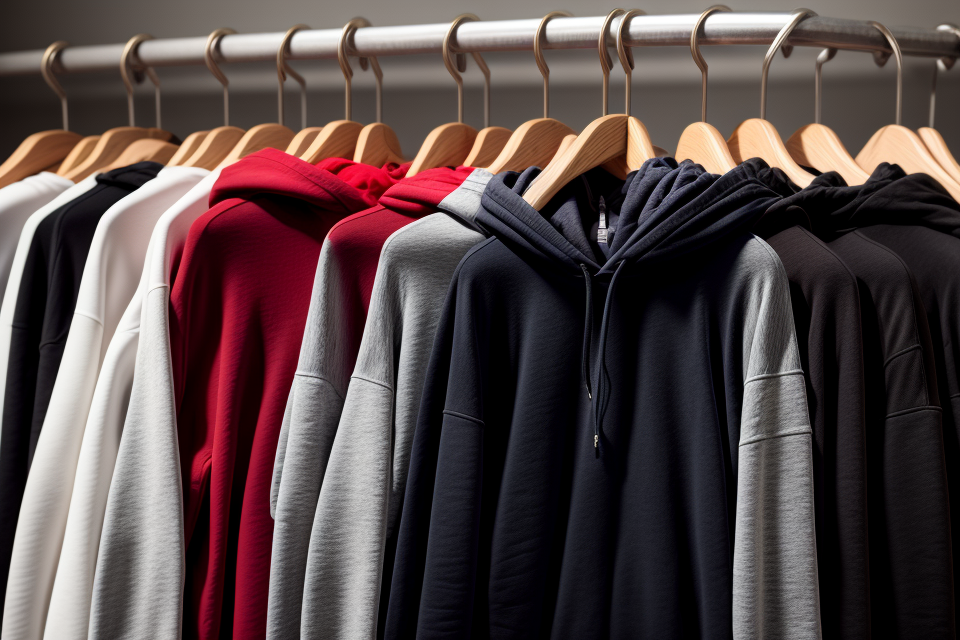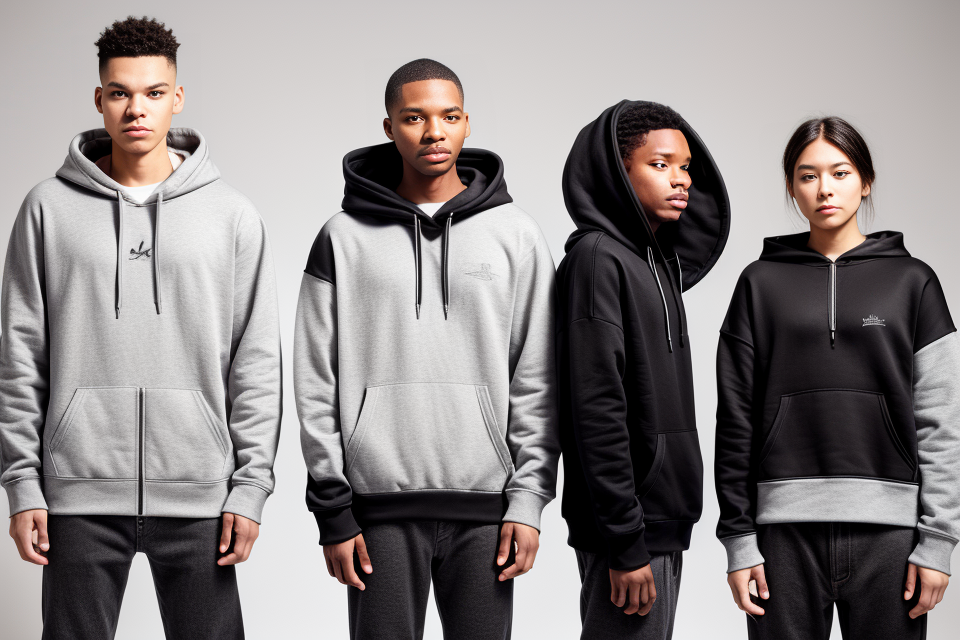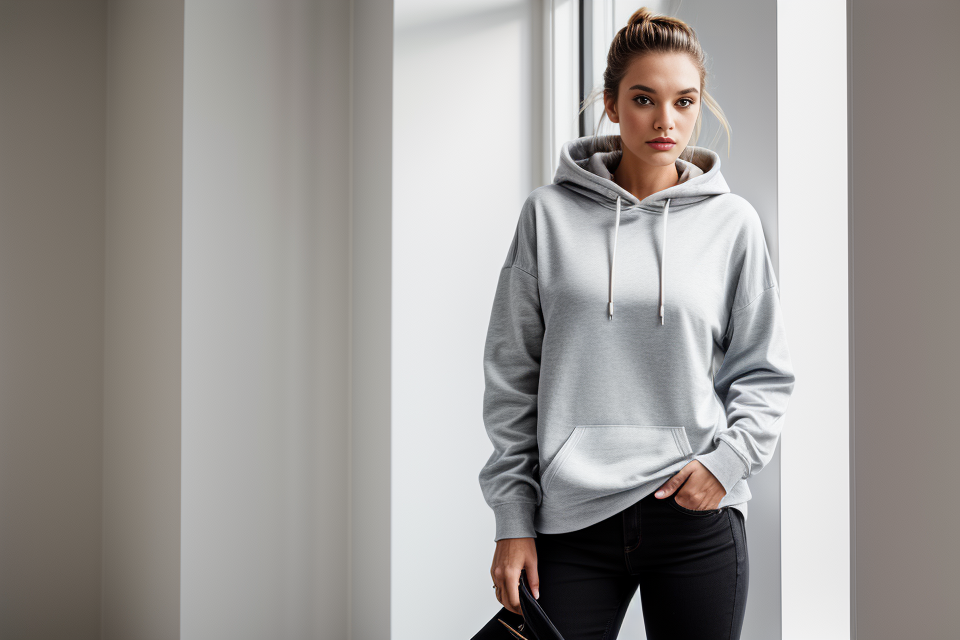
When it comes to clothing, there are many different options to choose from. Two popular types of tops are pullovers and hoodies. But are they the same thing? In this comprehensive guide, we will explore the differences between pullovers and hoodies, and help you understand what sets them apart. Whether you’re a fashion enthusiast or just looking to update your wardrobe, this guide will provide you with the information you need to make an informed decision. So, let’s dive in and find out what makes these two clothing items unique!
What is a Pullover?
Definition and Characteristics
A pullover is a type of sweater that is designed to be pulled over the head and arms, as opposed to being worn open like a cardigan. The term “pullover” is often used interchangeably with “sweater,” but a pullover is typically a more casual garment that is designed to be worn as a layer underneath other clothing or as a standalone top.
In terms of physical characteristics, a pullover typically has a round neckline, long sleeves, and a tubular construction that allows it to be pulled over the head and onto the arms. Pullovers can be made from a variety of materials, including wool, cotton, acrylic, and synthetic blends. They are often designed to be worn in cooler weather or as a layer underneath a jacket or coat.
While a hoodie is also a type of sweater, it is distinct from a pullover in several ways. A hoodie typically has a hood that can be adjusted to cover the head and neck, as well as a front pocket or pockets. Hoodies are often worn as a standalone garment and are commonly associated with a more casual, athletic style. While pullovers can be made from a variety of materials, hoodies are typically made from cotton or cotton blends and are often associated with a more relaxed, comfortable fit.
Types of Pullovers
Pullovers are a type of garment that can be worn over a shirt or t-shirt to provide an extra layer of warmth or to complete an outfit. There are several types of pullovers available, each with its own unique features and styles.
- Crew neck pullovers are a classic and versatile option. They have a round neckline and short sleeves, making them suitable for both casual and formal occasions.
- V-neck pullovers have a V-shaped neckline and are often worn untucked over a shirt. They can be dressed up or down, making them a popular choice for both men and women.
- Turtleneck pullovers have a high, rolled neckline that sits around the neck and is designed to keep the neck warm. They are often worn under a jacket or sweater, but can also be worn on their own.
- Hooded pullovers have a hood that can be pulled up over the head to provide extra warmth. They are often worn as part of a uniform or as a sports team’s jersey.
Each type of pullover has its own unique style and can be worn in different ways to create a variety of looks. Understanding the different types of pullovers available can help you choose the right one for your needs and preferences.
What is a Hoodie?
A hoodie is a type of sweatshirt that is characterized by a hood in the back that can be worn over the head. The hood provides additional coverage for the head and neck, making it a popular choice for outdoor activities and cold weather. The term “hoodie” is often used interchangeably with “sweatshirt,” but the two garments are not the same.
Physical Characteristics of a Hoodie Garment
A typical hoodie garment has a T-shirt style design with short sleeves and a round neckline. The hood is usually lined with a soft, warm fabric such as fleece, and can be adjusted to cover the head and neck. Some hoodies also have a drawstring to adjust the hood’s size. The body of the hoodie is typically made of a heavy, warm fabric such as cotton, fleece, or polyester. The sleeves may be cuffed or uncuffed, and the hemline may be ribbed or unribbed.
Common Materials Used for Making Hoodies
Hoodies are typically made from a variety of materials, including cotton, polyester, fleece, and a blend of these fabrics. Cotton hoodies are usually warmer than polyester hoodies, but they are also more expensive and require more maintenance. Fleece hoodies are lightweight and warm, making them a popular choice for outdoor activities. Blended hoodies are a good option for those who want a garment that is both warm and affordable. In addition to these materials, hoodies may also be made from recycled materials, such as recycled polyester or recycled cotton.
Types of Hoodies
When it comes to hoodies, there are several different types available. Understanding the differences between these types can help you make an informed decision when choosing a hoodie.
Full-zip hoodies
Full-zip hoodies have a full-length zipper that runs from the neck to the bottom hem of the garment. This allows for easy on and off, making them a popular choice for layering under jackets or for wearing as a standalone outer layer. Full-zip hoodies may also have pockets, either on the hips or the front, and a drawstring hood to adjust the fit around the neck.
Half-zip hoodies
Half-zip hoodies have a zipper that runs from the neck to the mid-chest area. This design allows for some ventilation, making them a good choice for cooler weather. Like full-zip hoodies, half-zip hoodies may also have pockets and a drawstring hood.
Pullover hoodies
Pullover hoodies have a non-removable hood and may have a front zip or a turtleneck collar. These hoodies are designed to be worn by pulling them over the head and shoulders, and they may have a drawstring hood to adjust the fit around the neck.
Oversized hoodies
Oversized hoodies are designed to be loose-fitting and comfortable. They may have a boxy silhouette and may be longer in length than other types of hoodies. Oversized hoodies are often worn as a casual, everyday garment and may have a relaxed fit.
Similarities Between Pullovers and Hoodies
- Both are types of sweatshirts: While a pullover and a hoodie may have different designs and styles, they are both classified as types of sweatshirts. Sweatshirts are typically made of a lightweight, breathable fabric and are designed to keep the wearer warm and comfortable.
- Both are usually made of cotton or cotton-blend fabrics: Pullovers and hoodies are typically made from a blend of cotton and other materials, such as polyester or spandex. Cotton is a popular choice because it is soft, durable, and absorbent, making it ideal for wicking moisture away from the body.
- Both are popular casual wear items: Pullovers and hoodies are popular choices for casual wear because they are comfortable, versatile, and easy to style. They can be worn as a layer under a jacket or coat, or as a standalone garment. They are often worn for exercise, as part of a uniform, or as a casual, everyday garment.
Differences Between Pullovers and Hoodies
Pullovers and hoodies are both types of sweatshirts, but they have distinct differences that set them apart. Understanding these differences can help you choose the right type of sweatshirt for your needs.
Pullovers do not have a hood, while hoodies do
A hood is a key feature of a hoodie, which is designed to cover the head and neck area. A pullover, on the other hand, does not have a hood, and is typically a more basic design. The lack of a hood means that a pullover may not be as suitable for outdoor activities or colder weather conditions.
Hoodies have a front zip or half zip, while pullovers do not
Another key difference between pullovers and hoodies is the presence of a front zip or half zip. A hoodie typically has a full front zip, which allows for easy on and off, as well as the ability to adjust the fit. A pullover, on the other hand, does not have a zip, and must be pulled over the head to put on. This can make it more difficult to put on or take off a pullover, and may not be as suitable for active wear.
Pullovers are often tighter-fitting than hoodies
Pullovers are often designed to be more form-fitting than hoodies, which can make them a popular choice for layering under clothing or for showing off a fitted silhouette. A hoodie, on the other hand, is often designed to be more relaxed-fitting, with a looser, more oversized design. This can make a hoodie a more comfortable choice for casual wear or for wearing as a standalone layer.
In summary, while both pullovers and hoodies are types of sweatshirts, they have distinct differences that set them apart. Understanding these differences can help you choose the right type of sweatshirt for your needs, whether you’re looking for a layering piece or a standalone sweatshirt.
Which One to Choose?
When it comes to choosing between a pullover and a hoodie, there are several factors to consider. Both garments have their own unique features and benefits, and the right choice will depend on your personal preferences, the occasion, and the climate. Here are some factors to consider when making your decision:
- Comfort and Fit: Both pullovers and hoodies are typically made from comfortable, stretchy fabrics that make them ideal for casual wear. However, the fit and feel of each garment can vary. Pullovers tend to be more fitted and may have a hood or a drawstring to adjust the fit. Hoodies, on the other hand, are often looser and have a more relaxed fit. Consider how each garment fits on you and which one you feel more comfortable in.
- Style: Hoodies are often associated with a more casual, streetwear-inspired style, while pullovers can be dressed up or down depending on the occasion. If you’re looking for a garment to wear to work or a formal event, a pullover may be a better choice. However, if you’re planning to wear your clothes for a more relaxed outing, a hoodie may be more appropriate.
- Occasion and Climate: The occasion and climate are also important factors to consider when choosing between a pullover and a hoodie. A pullover may be a better choice for cooler climates or for indoor settings, while a hoodie may be more appropriate for outdoor activities or warmer weather. Additionally, if you’re attending a formal event or meeting, a pullover may be more appropriate than a hoodie.
- Personal Preferences: Ultimately, the right choice between a pullover and a hoodie will depend on your personal preferences. Consider what you like about each garment and which one you feel most comfortable in. Take into account the material, color, and design when making your decision.
By considering these factors, you can make an informed decision about which garment is right for you and the occasion. Whether you choose a pullover or a hoodie, you can be sure that you’ll be comfortable and stylish.
FAQs
1. What is a pullover?
A pullover is a type of sweater that is worn by pulling it over the head. It typically has a round neckline and long sleeves. Pullovers can be made from a variety of materials, including wool, cotton, and synthetic fibers. They are often worn as a casual, everyday garment and are popular for their warmth and comfort.
2. What is a hoodie?
A hoodie is a type of sweatshirt that has a hood in the back to cover the head and neck. It is typically made from a lightweight, breathable fabric such as cotton or fleece and is often worn as a casual, everyday garment. Hoodies are popular for their comfort and versatility and are often worn as a layer underneath a jacket or as a standalone garment.
3. Are pullovers and hoodies the same thing?
No, pullovers and hoodies are not the same thing. While both are types of sweaters, they have distinct differences in their design and construction. A pullover typically has a round neckline and long sleeves, while a hoodie has a hood in the back to cover the head and neck. Additionally, pullovers are often made from heavier, warmer materials such as wool, while hoodies are typically made from lighter, more breathable fabrics such as cotton or fleece.
4. What are the advantages of wearing a pullover?
There are several advantages to wearing a pullover. One of the main benefits is that pullovers are very warm and comfortable, making them ideal for cooler weather. They are also often made from high-quality materials that are soft and cozy to the touch. Additionally, pullovers are a versatile garment that can be dressed up or down for a variety of occasions. They can be worn as a casual, everyday garment or as a more formal layer under a jacket or coat.
5. What are the advantages of wearing a hoodie?
There are several advantages to wearing a hoodie. One of the main benefits is that hoodies are very comfortable and casual, making them ideal for everyday wear. They are also often made from lightweight, breathable fabrics that are perfect for layering underneath a jacket or coat. Additionally, hoodies are a versatile garment that can be dressed up or down for a variety of occasions. They can be worn as a casual, everyday garment or as a more formal layer under a jacket or coat.


